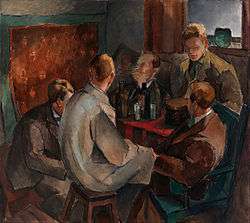November Group (Finland)

November Group (Marraskuun ryhmä) was an association of Finnish expressionist artists, gathered around Tyko Sallinen. The group was founded in time when Finland declared its independence from Russia and the members of the November Group were sometimes aggressively nationalistic in outlook, creating a distinctively Finnish form of Expressionism.[1] The November group caused the greatest ever uproar in Finnish art. In the Finnish art community of its age it represented everything that was ugly, incompetent, distorting and primitive. Today the movement is considered one of the most important and influenced movements in Finnish art.[2]
Members of the group included Tyko Sallinen, Marcus Collin, Alvar Cawén,[3] Juho Rissanen and Gabriel Engberg. These five had a group exhibition 17 November to 5 December 1917, and in decided to found a group during that exhibition.[4]
The group took its name from month of its first exhibition.[5]
Sallinen, Collin and Cawén had studied in France and were familiar with French fauvism and expressionism. However, they selected to use dark grey and brownish colours instead of the bright colours favoured by French fauvism. They also took influences of cubism and Russian cube-futurism.[5]
Many of the future group members had met each other in Denmark already in 1910, where they stayed with taylor Niels-Peder Rydeng, who became a patron and collector of modern art.[2]
References
- ↑ "November Group". The Oxford Dictionary of Art and Artists. Retrieved 23 October 2016.
- 1 2 "The November group: The Finnish Expressionist colony.". Obro Art Gallery. Rydeng. Retrieved 23 October 2016.
- ↑ von Bagh, Peter. "Omakuva joka täytyi piirtää". Sininen laulu (in Finnish). Yle. Retrieved 23 October 2016.
- ↑ "Alwar Cawén, Marcus Collin, Gabr Engberg, Juho Rissanen, T. K. Sallinen : Salon Strindberg 17.11. - 5.12.1917 [ei luetteloa]". Kirjava (in Finnish). Library of Finnish National Gallery. Retrieved 23 October 2016.
- 1 2 van den Berg, Hugo (2012). A Cultural History of the Avant-garde in the Nordic Countries 1900-1925. Rodopi. p. 561. ISBN 9789401208918.